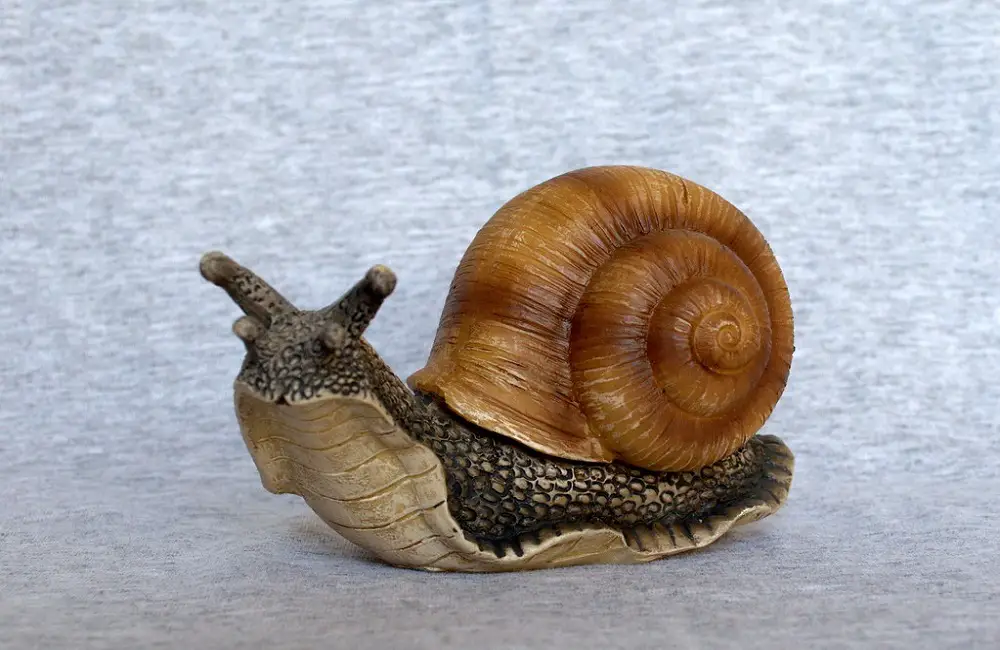Have you ever thought about how a snail eats and how they digest their food? I have done tons of research about snails and below is everything that you need to know about the eating habits of these little snails.
Snails lookout for food with the use of their powerful smelling ability. They eat with their jaws and thousands of their microscopic teeth, which are called radula. Their radula is the one that scrapes up food particles, and their jaw is the one that cuts the enormous food they intake, like a leaf.
But that is the very short version!
There are lots of things that I can say as you will see below. I have listed lots of fun facts and strange features about these tiny snails. They are very interesting animals!
I will also answer various questions related to our topic and list down different things that snails eat. The most exciting part is, that I will also tell you the various animals that prey on these little fellas. Now if you are ready, let us move on!
Related Article: How do jellyfish eat?
How Does A Snail Eat?
As I have told you above, snails will look out for their food with the use of their strong sense of smell. They will look for plants that smell tasty for them. Below are the detailed steps of how snails find food to how they release their manure.
First, How Snails Find Food
First, snails will find food. They are not like the jellyfish that are passively getting food.
Snails will use their strong sense of smell to find delicious and nutritious food. They mostly find food during the night because they are nocturnal animals to avoid their predators.
Snails Will Use Their Radula And Jaw
First of all, what is radula in snails?
The radula is an anatomical structure used by snails to eat. Sometimes radula is compared with the tongue. The radula is a small tooth that is used for scraping or cutting food before entering the esophagus.
The radula of snails grinds up food by moving back and forth quickly while their jaw holds the food in place. In simple words, the radula is the one that helps snails to grind their food, and their jaw is the one that is used to cut down enormous food and hold the food in the place.
The Digestive System Of The Snails
After snails have taken their food, their food will disappear in the snail’s esophagus to be digested.
Snails already digested their food inside their mouth, which is also called first digestion. The saliva of snails is produced by two large salivary glands on both sides of the crop. The salivary glands are the ones that digest carbohydrates, like starch and sugar.
The protein and celluloses they intake are not digested by the salivary enzymes. The saliva of the snail is powerful because it makes the food pulp so that it can be easier to be transported into the esophagus.
The stomach or crop is a blind sack where salivary glands are found. This is where the food pulp is dammed. This part is where the prime part of digestion takes place. There are bacteria in the crop that helps the snail digest cellulose and protein.
After a long time of digesting their food, it is time to release their manure.
How Do Snails Release Their Waste?
The food of the snail will enter the large intestine, where the nutrients are absorbed. The food that has not been digested will be released through their anus.
How Long Do Snails Eat?
Snails will sometimes eat for 24 hours, depending on how large the food. Sometimes it can take them up to two days if they are given large lettuce or leave.
What Do Snails Eat?
Terrestrial snails are herbivorous, which means they eat plants. However, other snails are omnivorous, and some snails are carnivorous, which is hard to believe! There are many species of snails around the world, and each of them has different eating habits. It depends on their size, age, habitat, and nutritional requirements.
The herbivorous snails will eat a wide variety of plant parts, such as leaves, stems, plant crops, bark, and fruits. Some of them also consume fungi and mushrooms, and some of them will eat algae. However, this only happens occasionally. Fungi, mushrooms, and algae are essential food for freshwater snails.
Some snail species are detritivores, which means they eat decaying waste from plants and other animals. These snails will enjoy eating plants that are already dead, as well as animals or any dead thing.
There are also carnivorous snails which is hard to believe! Even, I don’t imagine that there are snails that eat flesh! These carnivorous snails will eat gastropod mollusks, such as slugs and earthworms. One carnivorous species of snail is the genus Powelliiphanta which lives in New Zealand.
Next are the omnivores. Omnivore snails can eat plants and animals. However, they usually prefer to eat other terrestrial animals, so it means they are predators like the carnivorous snails. Rumina decollata is an omnivorous snail that eats other species of conch, slugs, and worms. But sometimes they will also eat plants.
Every snail has to eat foods that have enough calcium to keep its shells hard. How do they know that the food has calcium? They use their strong sense of smell! When finding food, snails will use their sense of smell. They are like dogs!
Snails are nocturnal animals, which means they hunt during nighttime or early morning hours. They do this to avoid various predators that are awake during the daytime. Snails will eat lots of food if the winter approaches. They do this to store up fat reserves while they hibernate.
Sometimes food sources are low in summer or springtime. When this happens, snails will voluntarily put their bodies into a state of estivation. This kind of strategy allows them to survive.
Animals That Eat Snails
The snails are also in danger of being eaten by other animals, even if they are carnivorous. The animals that eat snails are:
- Ground beetles
- Pathogens
- Snakes
- Toads
- Turtles
- Birds
- Omnivorous and carnivorous snails
- Cats
- Dogs
- Wild turkey
- Grouse
- Salamanders
- Squirrels
- Mice
- Humans
Our ancestors hunted and ate land snails. Even today, there are still some restaurants that serve snails. Mostly in Asian and European countries. Snails are not common in areas of America. Also, it is not a big deal to eat a snail since they are not endangered species and can be found anywhere!
However, if you want to eat snails, you have to cook them properly. If you don’t cook the snails or slugs properly, you can get a parasitic infection, which can be dangerous. You can get a headache and fever for a few days. So cook your snail adequately!
There is a farm of snails that is called Heliciculture. It is the process of raising edible land snails. These snails are for human consumption or cosmetics. If you want to cook a snail, it is better to go to a local farm than to hunt a snail from your backyard.
FAQs On Snails
Can a snail bite you?
Yes! Snails can bite you using their thousands of teeth. However, it will not hurt you because it is a lack of force. It just feels like a brush scraping your finger. However, some snails can bite you painfully, but luckily, there are only a few of them.
Is it dangerous to touch a snail?
There are only a few snails or slugs that are poisonous or harmful to humans. However, touching a snail even though it has no venom can pass on the infecting agents. Snails and slugs look harmless, but they can kill you if they have parasitic nematodes.
How long does a snail live?
Most species of snail are known to live for one year. However, some species of snail can live up to two to three years. Also, the larger species can live up to ten years.
Summary
Snails eat using their radula and jaws. They use their radula to scrape or rasp their food. The jaw is the one that cuts off larger pieces of food, that will be rasped by the radula. Snails will digest their food two times.
The first digestion is in their mouth where they grind their food, while the second digestion is in their crop where they have bacteria to help them digest protein and cellulose.
Source: nhm.org, petshoods.com, snail-world.com




